I was looking through photos from Fractracker and had some questions!

_
Oil and gas drilling in ND. Photo by Nick Lund, 2014, via Fractracker Alliance
_
Many of the photos have this characteristic shimmering air. What causes this? This one, for instance, looks like clean-burning flame (i.e. no smoke) which suggests that whatever is being burned is being wholly converted with very little carbon or soot. I realized I had no idea what I was looking at.
- Heat haze (where you're seeing a refraction of light due to convection and temperature)
- Gas cloud (where you're seeing a refraction of light due to -- new molecules floating around?)
- Invisible smoke (where you're seeing -- refraction due to tiny particles? but that would just be haze)
I don't know much about how fire works.
I guess a related question is: Can you tell anything about a flare based on how dirty the smoke is?
This conversation may get a little write-up FYI.
The shimmering air is probably caused by refraction. The heated air has a different RI then cold air. So you get shimmering. You see it in dry places like the sahara, etc.
As for the paticulate, there should be a way to detect it. But if you are at any distance, visual methods combined with the small particle size, could make it difficult. A better method could be to detect the flame temperature. This could be done by measuring the visual color or taking the temp with an IR thermometer.
As for the related question. I wouldn't look for particulate matter. Instead, I would try atomic emission. The hottest part of the flame is above the colored part of the flame. Certain elements will emit light when heated in these flames. Often, it takes nitrous oxide/ acetylene flames to get elements not enough. But there are some that work at lower temps. It's a variation on putting elements in a Bunsen burner and watching the flame change color. It would take development work, but it might be feasible.
Reply to this comment...
Log in to comment
I think it's both, right?
Emission bands give you a spectra you can match. The blue light that's emitted from a regular flame, swan bands, for instance, are emission spectra from free carbon radicals. They're characteristic of hydrocarbon flames (which is, like, most flame). Exothermic reaction releases a photon, but the reaction isn't tied to temperature.
Blackbody radiation is based on heated particulate matter, and its color is directly linked to temperature. If you know what's burning you can match it and find the temp, or you can take the temp. But it's hard, because you're very rarely burning anything discrete. If I'm burning a piece of wood or a pile of paper, a lot of that is carbon, but there's a lot of other stuff mixed in. I assume stack emissions are the same. You're never burning only sulfur or copper-based compounds. You're burning a mix, and so it's hard to identify based on emission spectra or blackbody radiation alone.
That's why I asked about the lack of smoke. I take it as a sign that whatever is burning is fully combusting, so you're getting a full conversion. If that's the case, it might be easier to identify? (less soot, less random carbon, fewer particulates, less mess, more likelihood of being able to identify discrete compounds). But I think that's a little optimistic.
Is this a question? Click here to post it to the Questions page.
Reply to this comment...
Log in to comment
In this picture, for instance, there's no blue. So maybe it's not carbon?
That's a stretch, though. Swan bands are hard to see in the daylight.
Is this a question? Click here to post it to the Questions page.
Reply to this comment...
Log in to comment
The emission bands would be best seen at night. And they are flame condition dependent. So you would want to monitor the flame some way.
The best way to monitor would be in dead air. The blowing wind would mess things up.
Sulfur and TENORM, now your getting into the experimental phase. The flame temp should be measurable from a distance. The rest of it.. It will take some work to say the least.
Reply to this comment...
Log in to comment